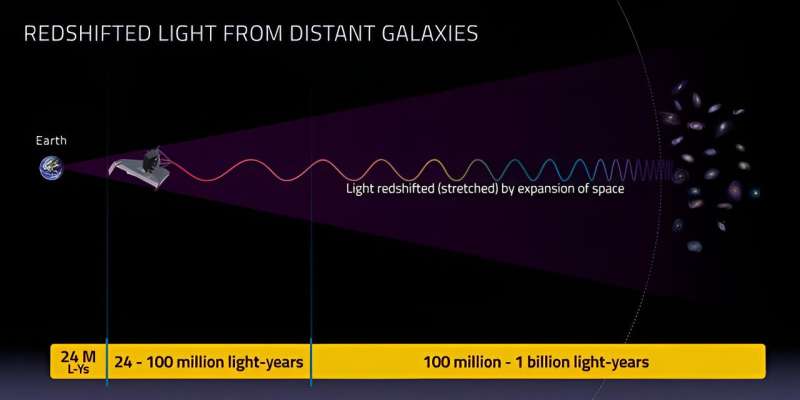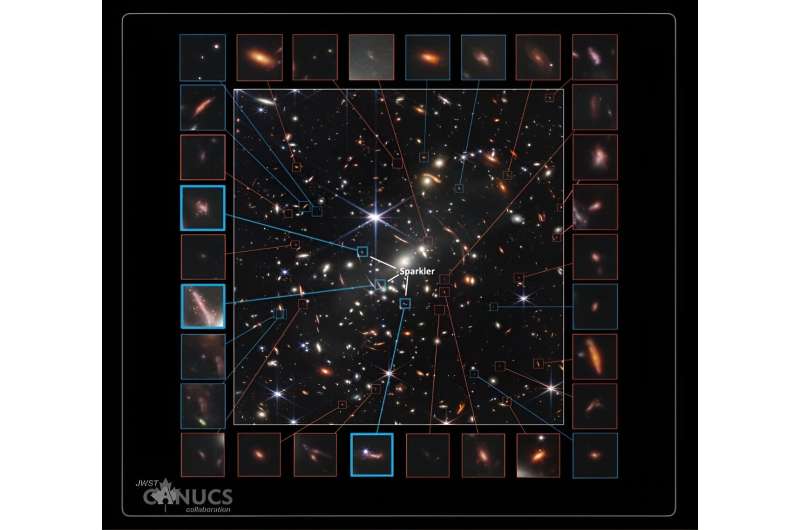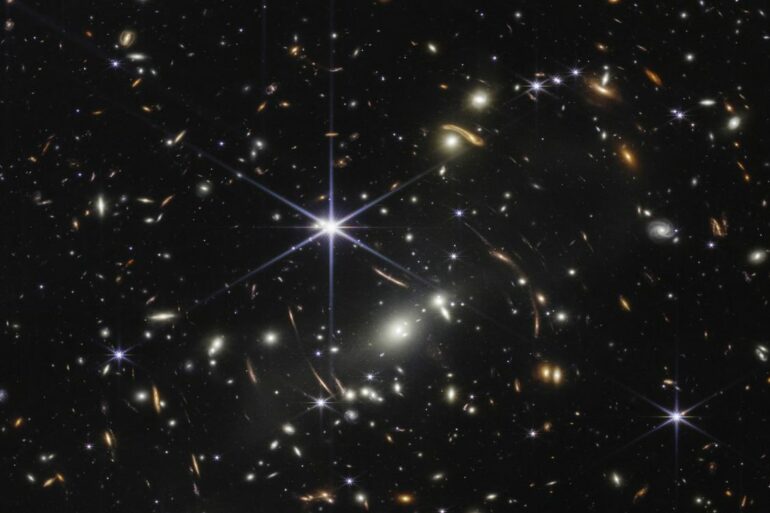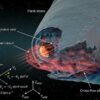On July 11, 2022, the very first image taken by the James Webb Space Telescope (JWST) was released to the general public. It’s called Webb’s First Deep Field, centered on a cluster of galaxies named SMACS 0723 and containing no less than 7,000 galaxies.
This image has proven to be an important target for the study of galaxy evolution as it contains a large number of very distant galaxies which shed light on how galaxies formed and evolved in the early universe.
Until now, however, there has been a lack of accurate and comprehensive distance measurements to galaxies in this field.
A team of Canadian and international astronomers led by Dr. Gaël Noirot, a postdoctoral researcher at Saint Mary’s University in Halifax, has now carefully inspected and analyzed Webb’s First Deep Field. Their study is published in the Monthly Notices of the Royal Astronomical Society.
Members of the Canadian NIRISS Unbiased Cluster Survey (CANUCS), the scientists used the Canadian NIRISS (Near Infra-Red Imager and Slitless Spectrograph) instrument onboard the JWST to collect spectra from galaxy targets in the image. These spectra are a type of scientific data created by breaking down the light of an object to reveal additional information such as the object’s age or distance.
Charting the ‘redshifts’
Using JWST’s made-in-Canada NIRISS instrument, the team measured the “redshifts” (shifts in the spectra of very distant galaxies toward longer wavelengths) of nearly 200 galaxies whose distances from Earth were previously unknown. “NIRISS is perfect for doing this because it can measure the redshifts of hundreds of galaxies at once,” said Noirot, the study’s lead author.
“Redshift” is a precise measurement of a galaxy’s distance based on the unique chemical signatures seen in its spectra. Because the universe is expanding, the light emitted from distant objects such as galaxies is being stretched, and their spectral features are seen at longer (i.e., redder) wavelengths than originally emitted. This redshift, which is the difference between an object’s observed and emitted color, reveals its distance from Earth.

This image shows the principle of cosmological redshift. As shown, the light from distant galaxies is being stretched into longer wavelengths as it travels through our expanding universe. When observed with a telescope like JWST, this makes the light of those galaxies appear redder than originally emitted, as longer wavelengths correspond to redder colours. © CSA/STScI: https://www.asc-csa.gc.ca/eng/multimedia/search/image/15614
“Our work on SMACS 0723, Webb’s First Deep Field and first science image ever released by JWST, has produced the largest JWST spectroscopic catalog of its kind with reliable redshift measurements,” said co-author Marcin Sawicki, a professor and Canada Research Chair at Saint Mary’s. “Our recently published study will be a valuable resource for the astronomical community and open up new avenues of research,” added Noirot.
From this redshift catalog, the researchers have uncovered many new galaxies in the SMACS 0723 cluster whose light has taken more than 4 billion years to reach us. Clusters, which are huge groups of galaxies held together by the force of gravity, can contain up to thousands of galaxies.
The new study brings better understanding of how galaxies evolve in some of the most extreme environments in the universe and gives a glimpse into the distribution of dark matter and the evolution of structures.
“As members of a Canadian-led project, we are even more excited that this significant improvement, compared to previous studies of SMACS 0723, was enabled by the spectroscopic capabilities of the Canadian-made instrument NIRISS on board JWST,” said the National Research Council’s Chris Willott, who leads the CANUCS team.
‘Using it to its full potential’
“This Canada-made technology is letting us use JWST to its fullest potential,” added Université de Montréal professor René Doyon, director of the Trottier Institute for Research on Exoplanets and principal investigator behind the NIRISS instrument. NIRISS designed, built, and tested in Ontario by Honeywell Aerospace, at its facilities in Ottawa and Cambridge. UdeM contributed key optical components, as well.
Within their huge collection of galaxy redshifts, the researchers identified three other galaxy overdensities at much greater distances than SMACS 0723 that had not been seen previously in this field. These galaxy overdensities are potentially newly discovered galaxy clusters located eight to 10 billion light years away.
Capturing these galaxy overdensities at different cosmic times is like watching a time-lapse movie of these clusters’ growth, from their infancy in a young universe to the present day.
The clusters represent ideal targets for future studies to better understand how galaxies and the clusters they inhabit have evolved from their state in the very early universe into what they look like today, including our own galaxy, the Milky Way, the scientists say.

This image shows the Webb First Deep Field of Galaxies, the very first unveiled science image by JWST. Galaxies that are part of the cluster of galaxies SMACS 0723 appear predominantly white in this image. Galaxies appearing redder and/or elongated are distant galaxies located behind SMACS 0723. Among those, the ones highlighted in blue are part of one of the newly discovered galaxy overdensities published in the new redshift catalogue. “The Sparkler” is a galaxy imaged three times due to an effect called gravitational lensing and whose light has been magnified and distorted. Thanks to this effect, the CANUCS researchers had discovered last year that this galaxy hosts numerous bright “sparkles” which are potentially some of the oldest star clusters ever observed. Galaxies highlighted in red are potential members of the same newly discovered cluster of galaxies that contains The Sparkler. The researchers will follow-up on The Sparkler and its family of galaxies with new JWST observations they will obtain in this field. © NASA, ESA, CSA, STScI. Post-stamps: Shannon MacFarland (SMU)
The amazing ‘Sparkler’
Already, the CANUCS team has made an amazing find within one of these clusters: the magnificent Sparkler galaxy. Discovered in September 2022, it’s a highly magnified galaxy, some 9 billion light years away, bursting with what appears to be the oldest star clusters to have formed after the Big Bang.
What the team’s new NIRISS redshift catalogue now reveals is that the Sparkler is not an isolated galaxy, but resides in one of the newly discovered galaxy overdensities.
“The fact that the Sparkler does not live alone but is a member of a family of galaxies has important implications for how first star clusters formed after the Big Bang,” said Sawicki, a co-author of the earlier study.
The CANUCS astronomers will be able improve upon their galaxy redshift catalog during Webb’s second year of scientific operations, now underway, as they have been granted time to re-observe Webb’s First Deep Field in even greater detail with the NIRISS instrument.
“The astronomy community clearly recognized the value of our first NIRISS redshift catalog and wants us to do another, even better version,” says Noirot, the principal Investigator of this observation program.
Several independent teams of scientists have used the catalog and the results of the new study to pursue their work on Webb’s First Deep Field, and additional research stemming from the CANUCS advances is expected into the formation of galaxies, the distribution of dark matter, and the evolution of the universe.
More information:
Gaël Noirot et al, The first large catalogue of spectroscopic redshifts in Webb’s first deep field, SMACS J0723.3−7327, Monthly Notices of the Royal Astronomical Society (2023). DOI: 10.1093/mnras/stad1019
Provided by
University of Montreal
Citation:
Astronomers now know how far the Earth is from 200 galaxies (2023, November 1)



